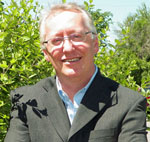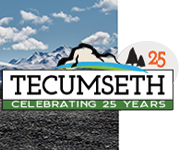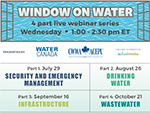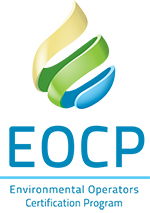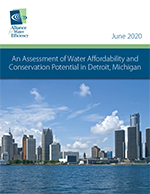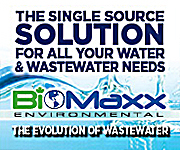 |
||||||||||||||||||||||||||||||||
| Subscribe | Past Issues | www.cwwa.ca | Water Source Magazine | ||||||||||||||||||||||||||||||||
|
CWWA News
We haven’t been able to get together at events as we normally have in the past, so you haven’t been able to hear my updates that I bring to all the regional and national events I can get to. Your CWWA has been VERY active at the national level advocating for our water utility sector.
In May of 2020 the federal government through Environment and Climate Change Canada with support from Agriculture and Agri-food Canada, released an early consultation on plans to develop a Canada Water Agency. Over the course of this consultation, the government will be publishing discussion aids and posing specific questions on their PlaceSpeak site to find out what Canadians would like to see in this new Agency and how we can further protections for Canada’s most important resource.
Federal Initiatives
The proposal is to amend the Regulations to make transitional authorizations that will expire at the end of 2030 or 2040 available for owners of wastewater systems that do not currently have one and are eligible. The proposal will be based on the existing eligibility criteria of the Regulations and the existing system of points in Schedule 2, and where applicable, Schedule 3. Any deposits that are not authorized under the Regulations remain subject to the general prohibition in subsection 36(3) of the Fisheries Act. A maximum acceptable concentration (MAC) of 0.05 mg/L (50 μg/L) is proposed for diquat (measured as the cation) in drinking water. Any exceedance of the proposed MAC should be investigated and followed by the appropriate corrective actions if required. Health Canada has published new final Guidelines for Drinking Water Quality for Enterococci as an Indicator in Canadian Drinking Water Supplies, a final guideline for Canadian drinking water quality for total coliforms and final guidance on natural organic matter in drinking water. On June 23, 2020, the Honourable Marc Miller, Minister of Indigenous Services, and the Atlantic First Nations Water Authority (AFNWA) signed a framework agreement that creates a path for the transfer of water and wastewater services for 15 First Nations communities in Atlantic Canada from Indigenous Services Canada (ISC) to the AFNWA.
For 20 years CWWA members have relied on the Window on Ottawa to keep them informed of federal priorities, initiatives and new legislation. Even more crucial is the opportunity to provide input and feedback to senior government officials, that have helped shape these policies and provided delegates feedback on their specific challenges with programs.
CWWA’s 2020 Annual General Meeting is scheduled for Monday, November 9, 2020 at 2:00 pm Eastern Time. This year’s AGM will be held virtually, and login information will be shared with prime contacts closer to the event. In the meantime you can access supporting documents from our website.
CWWA has updated our events calendar to reflect the changing landscape of events in 2020 and added CWWA and member events for 2021! After months of virtual meetings and conferences, we’re hoping that 2021 will bring us all back together for great events and learning opportunities. Attending events is a great way to reconnect and support your national and regional Associations. Member News
CWWA is distributing this survey on behalf of GWOPA/UN-Habitat. The survey results would be interesting for CWWA members, and encourage you to take a few minutes to complete it. GWOPA/UN-Habitat is pleased to cordially invite you to participate in a survey that aims at evaluating the use and relevance of Water Safety Plans or any similar risk management practice used by water utilities around the world to face the challenges posed by the COVID-19 crisis. Participation should require approximately 10-15 minutes of your time. You can access the survey in English, French or Spanish by clicking on the link below and consenting to participate after reviewing the information in the consent form
The Alliance for Water Efficiency released its report, An Assessment of Water Affordability and Conservation Potential in Detroit, Michigan, which evaluates water affordability and water conservation potential at the census tract level. Water affordability is an incredibly important issue, and the Alliance for Water Efficiency is dedicated to advancing the conversation by applying and evaluating measures of affordability and quantifying the benefits of water conservation. Through our efforts we aim to better understand and define the problem, and work toward solutions to help communities that are disproportionately impacted by water and sewer bills.
Provincial News
Now in effect, the legislation aims to protect critical infrastructure from illegal incursions and unlawful protests. Among other things, it designates pipelines, processing plants, refineries, roads, mines, oil production sites, oil sands sites, pits, quarries, storm drainage systems, telecommunication lines, transmission lines, waste management facilities, wastewater systems, watercourses, highways, transportation systems, railways, power plants, agricultural operations, as essential infrastructure. Snippings & Clippings
ESE Magazine The small town of Bow Island, Alberta, southeast of Calgary, with a population of about 2,000, is facing a series of water-related charges under the Environmental Protection and Enhancement Act for offences alleged to have occurred between January 1, 2014 and December 31, 2017. Water Canada The Great Lakes and St. Lawrence Cities Initiative (GLSLCI) has called on U.S. and Canadian elected officials to include water restoration priorities in any upcoming economic stimulus programs. In addition to economic stimulus, the funding would help safeguard coastal resources and mitigate future damage from erosion, flooding, and severe storm events. It would also: Engineering News-Record The last train that carried water into the parched city of Chennai rolled out of town Oct. 9, almost four months after officials declared the city at “day zero”—with no water for a population of more than eight million people. For those months, people lined up to get their allotment of water brought from the countryside by rail car or by tanker truck. Fights broke out, and worldwide attention was focused on this, the first major city in the world to go completely dry. Global News The term “flushable” for many years has created challenges for those in the wastewater treatment sector. Progress was being made thanks to multiple education campaigns about what should and should not go down the toilet, but the coronavirus pandemic caused a setback. BBC News Water companies say they have been inundated with requests from pubs and bars to pour beer down drains. Millions of pints of beer have gone off in pub cellars since businesses shut in March and now they have to apply for permission to dump it in sewers. Water Canada The Canadian water sector has proven to be one of the most resilient essential services in the wake of the COVID-19 pandemic. Water utilities, both public and private, were clearly prepared to deliver high-quality service in the wake of an unfathomable disruption. National Post (opinion piece) With the rosy glow from Canada Day still fresh in the memory, Canadians can reflect with pride on the watery wonderland they call home — a pristine wilderness, bordered by three mighty oceans, that contains one-fifth of the world’s fresh water and two million lakes. The reality is a little less pleasant on the senses. treehugger.com Much like when we throw things in the trash and they miraculously disappear from our homes, the same wizardry happens when we flush things down the toilet. Out of sight, out of mind – a feat of magical thinking that allows us to continue creating waste with nary a twinge of accountability. Journal of Water Process Engineering The world is facing the third coronavirus caused pandemic in less than twenty years. The SARS-CoV-2 virus not only affects the human respiratory system, but also the gastrointestinal tract. The virus has been found in human feces, in sewage and in wastewater treatment plants. It has the potential to become a panzootic disease, as it is now proven that several mammalian species become infected. Since it has been shown that the virus can be detected in sewage even before the onset of symptoms in the local population, Wastewater Based Epidemiology should be developed not only to localize infection clusters of the primary wave but also to detect a potential second, or subsequent, wave. To prevent a panzootic, virus removal techniques from wastewater need to be implemented to prevent the virus dissemination into the environment. Water Canada The Alberta government is working to address the impacts to water users resulting from an infrastructure failure in Montana. On May 17, a concrete drop structure failed on the St. Mary Canal, which is located in northern Montana and owned by the U.S. Bureau of Reclamation. The canal diverts water from the St. Mary River to the Milk River in Alberta. Permanent repairs to the canal will begin immediately, with completion scheduled for September. Repairs will be paid for by U.S. officials. Water Canada Thunder Bay’s City Council approved an interest-free loan program on June 22, 2020. The program will allow property owners to borrow funds from the City to assist in the replacement of privately-owned lead water service pipes. NJ Spotlight The first harmful algae blooms in two New Jersey lakes this summer have renewed fears that many lakes will be closed to swimmers and boaters for the second straight year, but conservationists say the problem could be addressed in the long term if local governments set up stormwater utilities. Environmental and Science Engineering Magazine A new World Economic Forum (WEF) report identifies water as a global systemic risk that could have an annual investment gap of $670 billion in relation to water security and water investment opportunities around food and energy production, as well as water quality and infrastructure. |
||||||||||||||||||||||||||||||||
